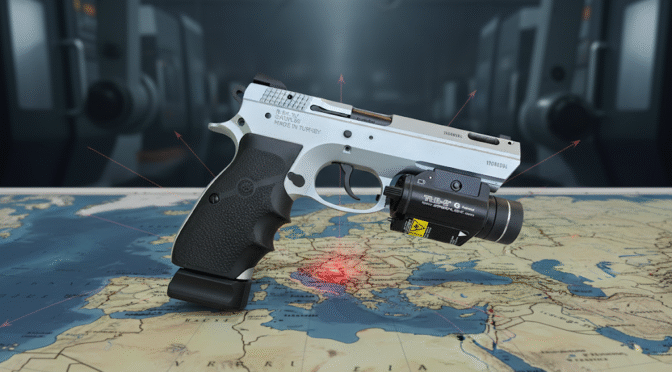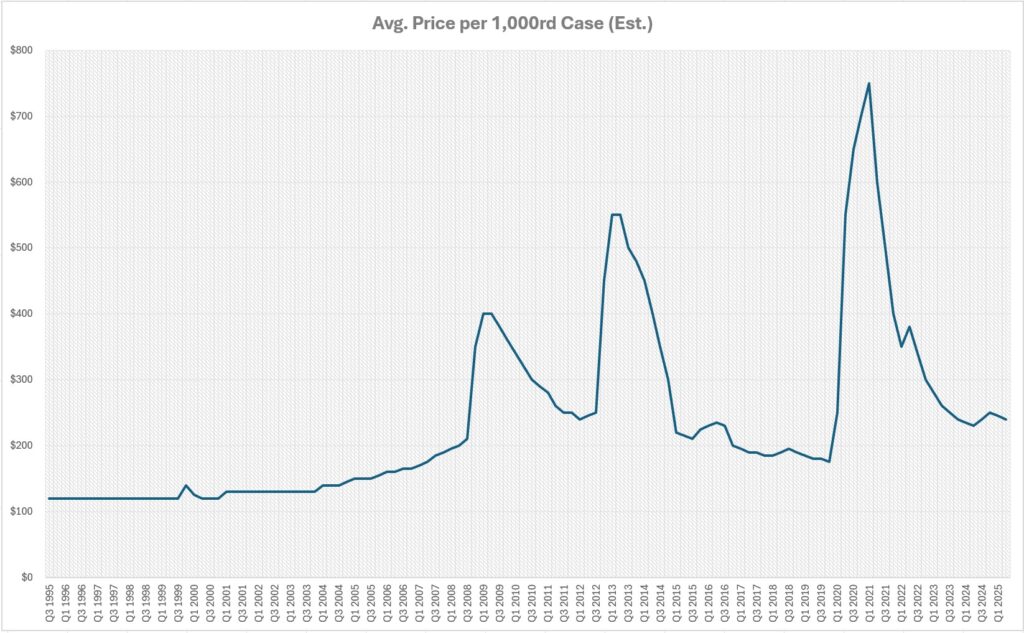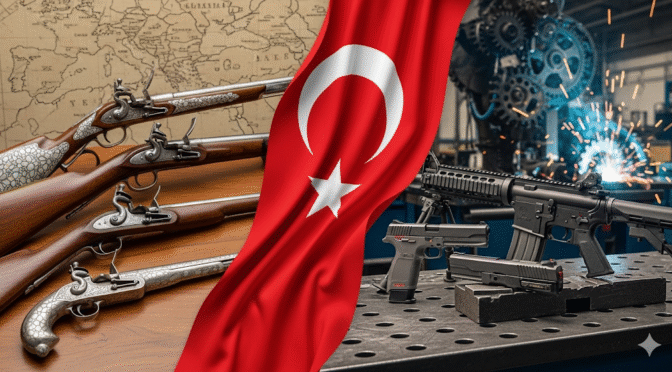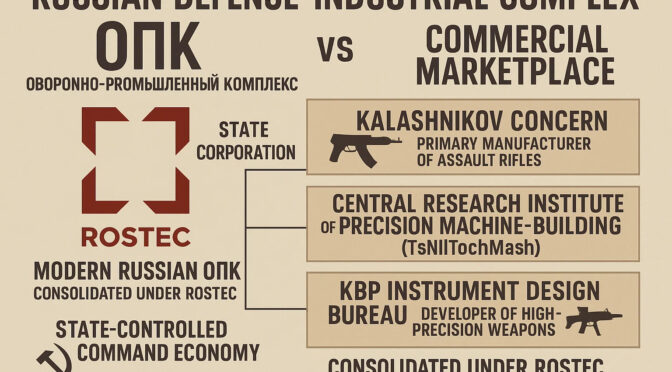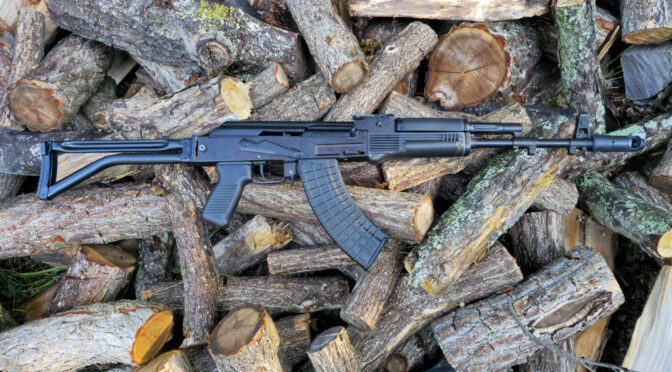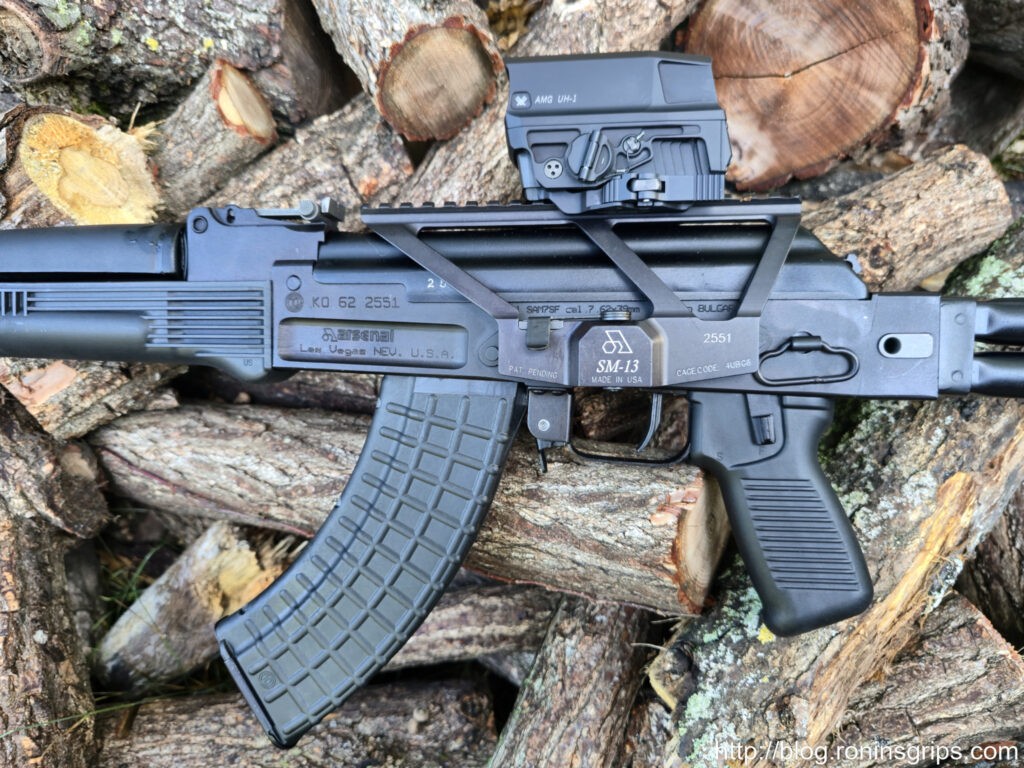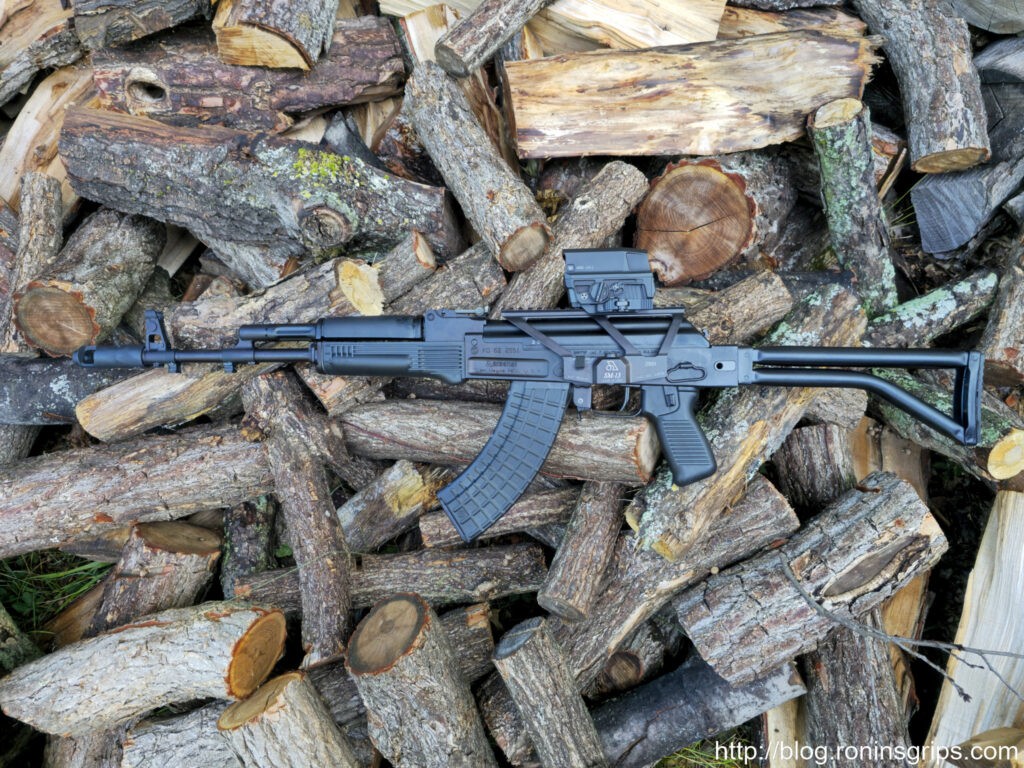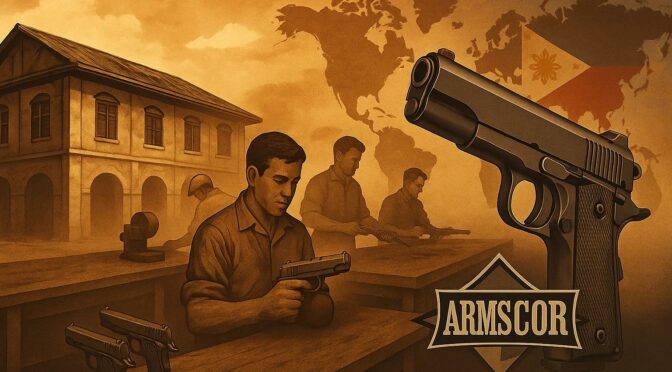The ascent of Canik from a relatively unknown Turkish defense contractor to a dominant global force in the firearms industry represents one of the most compelling strategic case studies of the 21st century. This report posits that Canik’s decision to produce high-quality clones of the Česká zbrojovka Uherský Brod (ČZUB) CZ-75 pistol was not merely an act of imitation, but a deliberate and masterfully executed corporate strategy. This initial phase of their firearms division served as a low-cost, high-impact research and development program, a public demonstration of their advanced manufacturing capabilities inherited from the aerospace sector, and a crucial “apprenticeship” in the nuanced art of firearm design. By mastering the complexities of the CZ-75—a platform renowned for its superb ergonomics, innovative mechanics, and demanding manufacturing tolerances—Canik acquired invaluable institutional knowledge. The lessons learned in metallurgy, trigger mechanics, human factors engineering, and market positioning were directly transposed to their subsequent, and now famous, TP9 series of polymer-framed, striker-fired pistols. This foundational experience enabled Canik to bypass the protracted and costly development cycle that typically encumbers new entrants, allowing them to rapidly disrupt the market with products that offered a superior value proposition. The journey from the Canik 55 series of CZ-75 clones, including the notable Shark model, to the award-winning TP9, METE, and Rival platforms is a direct and traceable lineage. This analysis will deconstruct this strategic pathway, demonstrating how a calculated period of imitation ultimately forged a legacy of innovation.
The Unprotected Legend: The CZ-75 as a Global Design Standard
To comprehend Canik’s strategic calculus, one must first understand the unique and revered position of its chosen subject: the CZ-75. In the mid-1970s, the CZ-75 was not just another handgun; it was a watershed moment in firearm design. Its emergence from behind the Iron Curtain, combining the best features of contemporary Western pistols into a single, brilliantly executed package, made it an object of immense desire and respect. However, the very geopolitical climate that shrouded its creation also left it uniquely vulnerable, creating a perfect storm of technical excellence and legal accessibility that would define the handgun market for decades.
The “Wonder Nine” Blueprint: An Engineering Analysis
Designed by the legendary Koucký brothers, who were given complete creative freedom, the CZ-75 was a clean-sheet design intended to be the best 9mm combat handgun imaginable within the constraints of Soviet-era manufacturing.1 Its immediate and lasting acclaim was not accidental; it was the result of a masterful synthesis of proven principles and innovative applications, making it a prime candidate for any manufacturer seeking a world-class blueprint.
The most distinctive feature of the CZ-75 is its slide-in-frame construction, where the slide rails are machined on the inside of the frame, and the slide rides within them.3 This design, borrowed from the highly accurate but expensive Swiss SIG P210, provides several key advantages. It creates a much tighter slide-to-frame fit, which enhances mechanical consistency and contributes to the platform’s renowned out-of-the-box accuracy. Furthermore, it allows the barrel and slide to sit lower in the frame, resulting in a lower bore axis. This geometric advantage directly translates to reduced muzzle flip and felt recoil, allowing for faster and more accurate follow-up shots.5 While mechanically superior, this design choice is also far more demanding from a manufacturing perspective, requiring higher precision and tighter tolerances than the more common slide-over-frame design. Successfully replicating it was a testament to a manufacturer’s skill.
Beyond its mechanical layout, the CZ-75’s ergonomics were revolutionary. The grip angle and shape are almost universally praised for feeling exceptionally natural and comfortable in a wide variety of hand sizes, providing excellent control and pointability.2 This focus on human factors was a critical element for a pistol designed explicitly for the global export market.
Finally, the pistol’s versatile DA/SA (double-action/single-action) trigger system offered the best of both worlds to Western consumers. It could be carried with the hammer down for a long, deliberate, and safe first trigger pull, or, thanks to its frame-mounted manual safety, it could be carried “cocked and locked” like the venerable M1911, ready for a crisp single-action first shot.3 This flexibility appealed to a broad spectrum of users, from law enforcement to civilian shooters accustomed to different manual of arms. The combination of these features—accuracy-enhancing mechanics, superb ergonomics, and a versatile trigger—cemented the CZ-75’s status as one of the original “wonder nines” and earned it the high praise of experts like Colonel Jeff Cooper, who considered it one of the best 9mm service pistols ever made.3 To clone the CZ-75 was to borrow from this immense well of credibility.
The Patent Vacuum: A Geopolitical Opportunity
The technical brilliance of the CZ-75 alone would not have been enough to spawn a global dynasty of clones. The critical catalyst was a unique geopolitical anomaly rooted in the Cold War. Although designed in communist Czechoslovakia, a Warsaw Pact nation, the CZ-75 was chambered in 9x19mm Parabellum, a NATO-standard cartridge. This was a deliberate choice, as the pistol was not intended for domestic military use (which relied on Soviet-standard 7.62x25mm Tokarev and later 9x18mm Makarov cartridges) but was explicitly designed for export to lucrative Western markets.1
This export focus created a legal paradox. The original patents filed by František Koucký were classified as domestic “secret patents” due to potential interest from Czechoslovak armed forces.3 This practice was not unusual for inventions with military applications. However, a critical failure occurred in the process of declassifying these patents for international filing. For reasons tied to the complexities of Cold War-era bureaucracy and international law, ČZUB never managed to secure a world patent for the design.9
This failure had a profound and lasting consequence: the CZ-75 design effectively became public domain outside of Czechoslovakia’s borders.12 Any manufacturer with the requisite engineering and manufacturing capabilities could legally reverse-engineer and produce their own version of the pistol without fear of litigation or the need to pay licensing fees.1 This created a global free-for-all, opening the door for companies like Italy’s Fratelli Tanfoglio, Israel’s IWI (with its Jericho 941), and, later, Turkey’s Canik to enter the market with a world-class design.9
This confluence of factors created the perfect storm for an aspiring firearms manufacturer. A company seeking to enter the market could have chosen to copy an older, less desirable design that was off-patent, or risk the immense cost of developing a new platform from scratch. The CZ-75 presented a third, almost unbelievable option: a modern, state-of-the-art, highly respected design that was completely unprotected. It was the single best platform available for a company looking to prove its capabilities on the world stage.
Canik’s Strategic Entry: A Calculated Approach to a Saturated Market
Canik’s emergence into the firearms industry did not happen in a vacuum. The company’s decision to begin its handgun manufacturing journey with CZ-75 clones in the early 2000s was a highly calculated response to the prevailing market conditions, executed using a unique set of institutional capabilities that set it apart from typical industry entrants. It was a strategy designed to bypass traditional barriers to entry and establish immediate credibility in a crowded and skeptical marketplace.
The Firearms Market Circa 2000: The Value Gap
The U.S. handgun market in the late 1990s and early 2000s could be characterized as mature and relatively stagnant. Following a surge in sales in 1999, driven by Y2K paranoia, the market stabilized but did not see the dramatic growth that would characterize the post-2008 era.15 The market was stratified, dominated by established premium brands like Glock, SIG Sauer, Heckler & Koch, and Beretta at the high end, and a “budget” tier of manufacturers whose products were often associated with questionable quality and reliability.18
This stratification created a significant “value gap.” There was a growing cohort of consumers who desired the reliability, modern features, and performance of premium brands but were unwilling or unable to pay the associated price. This market niche was ripe for exploitation by a manufacturer that could deliver a high-quality product at an accessible price point. The viability of this “quality clone” business model had already been demonstrated by competitors. Taurus, for example, had found considerable success with its PT99 pistol, a clone of the Beretta 92 that offered additional features like a frame-mounted safety at a lower price. In 2000, the Taurus was lauded as one of the best values in self-defense handguns, proving that a well-made, affordable clone of a respected design was a winning formula.18 Canik was entering a market where the path to success for a new importer had already been illuminated.
Institutional DNA: From Aerospace to Small Arms
Crucially, Canik (operating under its parent company, Samsun Yurt Savunma or SYS) was not a typical firearms startup. Founded in 1998, the company’s roots were firmly planted in the high-precision world of aerospace and defense contracting.20 For years, it had served as a manufacturing partner for global giants like Boeing, Lockheed Martin, and Airbus, producing critical components that demanded the highest levels of engineering precision, advanced metallurgy, and rigorous quality control.22
This background endowed Canik with an institutional DNA fundamentally different from many of its competitors. From its inception, the company operated within a culture of extreme precision, adhering to stringent international standards such as ISO 9001 and NATO certification.24 This was not a culture they had to build; it was their core competency. Their challenge was not learning how to manufacture to tight tolerances, but rather how to apply that existing expertise to a new product category: small arms.
The Clone as a Low-Risk, High-Reward Vehicle
For a company with Canik’s specific profile, producing a CZ-75 clone was a strategic masterstroke. It perfectly aligned their existing capabilities with the identified market opportunity, creating a low-risk, high-reward pathway into the industry. This approach allowed them to minimize R&D costs by forgoing the enormous expense and risk of developing an entirely new platform from the ground up.25 They could focus their resources on what they did best: high-quality manufacturing and process optimization. The challenge was not one of design, but of execution.
Furthermore, this strategy allowed them to enter the market with a product that was already known, respected, and desired by consumers.25 They did not have to spend millions on marketing to convince the public that the fundamental design was sound; ČZUB and decades of positive reviews had already done that for them. Their only task was to convince the market that their version of that design was executed to a high standard and offered superior value.
This was more than just a business decision; it was a deliberate “gauntlet throw.” A new, unknown Turkish manufacturer entering the skeptical U.S. market could have started with a simple blowback pistol or a basic polymer frame design. Instead, Canik chose one of the more mechanically complex and difficult-to-manufacture service pistols of the era. This was a strategic signal to the market. Successfully producing a high-quality CZ-75 clone was a public demonstration that their aerospace background was not just marketing rhetoric but a tangible asset that translated into superior manufacturing capability. It was a proof-of-concept for the entire company, a way of telling the world, “We are not like other budget brands; we are aerospace engineers who happen to make guns.” This move built the foundational brand trust that their later, more original designs would critically depend on.
Technical Deep Dive: Deconstructing the Canik “Shark” and its Stablemates
Canik’s approach to the CZ-75 platform was not one of simple, direct replication. Their early offerings, particularly the Canik Shark FC and the all-steel S-120/P-120 models, were better described as interpretations. They demonstrated a deep understanding of the original design, while simultaneously introducing modifications aimed at specific market segments and value propositions. This process of reverse-engineering was, in fact, a form of re-engineering, showcasing a company already thinking beyond mere imitation.
The Shark FC: An Alloy-Framed, Ported Evolution
The Canik Shark FC stands as a prime example of Canik’s interpretive approach. Rather than a 1:1 clone of a specific CZ-75 model, it was a unique amalgamation of features and design cues, clearly influenced by other successful CZ derivatives like the Israeli IWI Jericho 941 (often known as the “Baby Eagle”).14
The most significant departure from many contemporary CZ-75 variants, such as the popular CZ 75 SP-01, was the Shark FC’s use of a lightweight aluminum alloy frame instead of steel.27 This design choice had a dramatic impact on the pistol’s characteristics. An empty Shark FC weighed approximately 27 ounces, a substantial reduction from the 38.4 ounces of a steel-framed SP-01 Tactical.27 This made the Shark a far more practical candidate for concealed or duty carry, addressing a different market segment than the heavier, range- and competition-focused steel models.
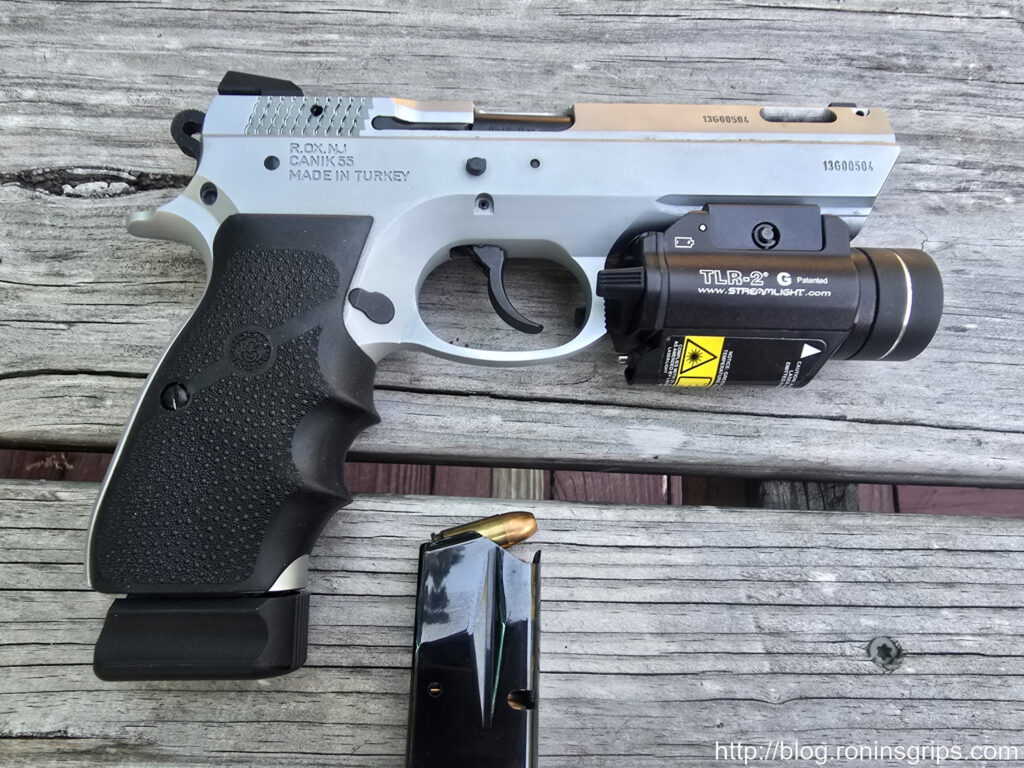
Another key differentiator was the inclusion of a ported barrel.27 This feature, typically reserved for competition or high-end custom pistols, was designed to vent gases upward to counteract muzzle flip. By incorporating porting as a standard feature, Canik was providing a tangible performance enhancement and a significant value-add that was not present on the standard CZ models it was competing against on the shelf. The overall aesthetic, with its full-length railed dust cover and distinctive slide profile, further reinforced its connection to the Jericho lineage, which itself was a highly successful evolution of the core CZ-75 design.
Shooter Feedback: Real-World Performance of the Shark FC
When looking back at the Shark FC, the consensus among shooters who owned and extensively used the pistol is overwhelmingly positive, particularly concerning its core performance attributes.
- Reliability: The Shark FC and its stablemates earned a reputation for being exceptionally reliable. Reports from owners detail firing hundreds and even over 1,500 rounds without a single malfunction.30 This reliability extended across various ammunition types, with the pistols cycling both brass and steel-cased ammunition without issue.27 This consistent performance solidified the perception that Canik was producing a robust and dependable firearm, suitable as a range gun, truck gun, or for home defense.50
- Accuracy: Shooters consistently found the Shark FC to be highly accurate, often on par with the original CZs it cloned.27 In direct comparisons, shot-to-shot accuracy was described as “pretty much indistinguishable” from a CZ SP-01.27 From a bench rest, the Canik-made clones were capable of producing impressive groups, often under three inches at 25 yards, demonstrating a high degree of mechanical precision.49
- Durability and Build Quality: The fundamental build quality was a point of praise, with shooters noting the excellent finish and tight slide-to-frame fit.27 The use of high-quality components like a steel slide and an alloy frame contributed to a feeling of durability.47 The primary point of long-term wear noted by users was the Cerakote finish, which, while well-applied, tended to show wear on contact points more quickly than the famously tough polycoat on original CZs.54 However, this was largely seen as a cosmetic issue that did not affect the pistol’s function.
- Trigger: The factory trigger on the Shark FC was a standout feature and a key part of its value. It was consistently described as “quite nice for factory,” with a smooth pull in both double and single action and a very clear, tactile reset point.27 While lauded as excellent out-of-the-box, some shooters felt the pull could be lighter with less travel.27 This led to a common and popular upgrade path where owners would install aftermarket spring kits and components from companies like Cajun Gun Works to achieve a competition-grade trigger feel.27
Comparative Analysis: Canik Clones vs. CZ Originals
A granular, engineering-focused comparison between Canik’s clones and CZ’s originals reveals a fascinating story of calculated trade-offs, manufacturing prowess, and strategic cost management.
Build Quality and Finish: Across numerous reviews, the consensus was that the fundamental build quality of Canik’s clones was remarkably high, often considered comparable to the original CZs.28 In some specific areas, Canik’s manufacturing even appeared superior. For instance, the Tristar P-120 (a Canik-made SP-01 clone) featured complex octagonal machining under the chamber, a costly process that strengthens the structure, whereas the equivalent SP-01 had a simpler, round chamber.28 However, this quality did not always extend to the finish. Canik’s use of Cerakote or similar spray-on finishes tended to show wear more quickly on bearing surfaces compared to CZ’s famously durable “polycoat” finish.28
Internal Components: An analysis of internal parts shows a mix of cost-saving measures and surprising upgrades. The Canik P-120, for example, utilized a Metal-Injection-Molded (MIM) hammer, a common and effective cost-saving technique, while the CZ SP-01 used a more robust and expensive billet-machined hammer. Conversely, the same Canik P-120 often shipped with a solid steel guide rod at a time when CZ was frequently using plastic guide rods in their standard models.28 This demonstrates a deliberate allocation of the manufacturing budget toward components that provided tangible benefits in durability and performance.
Parts Compatibility: For owners of clone firearms, parts compatibility is a critical consideration. Canik’s clones shared a high degree of compatibility where it mattered most for the end-user. Magazines, sourced from the same high-quality OEM manufacturer (Mec-Gar), were 100% interchangeable between Canik and CZ models.27 However, more integral components like slides and barrels were not simple drop-in replacements due to minor dimensional differences.27 Similarly, grip panels were not interchangeable, as the geometry of the Canik frame differed subtly from the CZ original.31 This lack of 1:1 interchangeability is significant; it indicates that Canik was not merely tracing existing blueprints but was engineering and manufacturing its own distinct components based on the CZ pattern.
The development of models like the Shark FC shows that Canik was not just asking, “Can we make a CZ-75?” They were asking, “Can we make a lighter, compensated CZ-75 for carry and range use at a lower price point?” This required a deeper level of engineering understanding than simple imitation. Changing the frame material from steel to alloy necessitates a complete re-evaluation of frame durability, recoil dynamics, and weight balance. Adding barrel porting requires a sophisticated understanding of gas pressures and their effect on slide velocity, recoil spring rates, and overall reliability. This process was not reverse-engineering; it was a comprehensive re-engineering of the platform to create a distinct product with a unique value proposition.
Table 1: Comparative Technical Analysis: Canik Shark FC vs. CZ 75 SP-01 Tactical
| Feature | Canik Shark FC | CZ 75 SP-01 Tactical | Analyst’s Note |
| Frame Material | Aluminum Alloy | Steel | The Shark’s alloy frame significantly reduces weight, making it more suitable for carry, while the SP-01’s steel frame absorbs more recoil, making it a softer-shooting range pistol.27 |
| Weight (empty) | ~27 oz | ~38.4 oz | A difference of over 11 ounces, fundamentally changing the handling characteristics and intended application of each pistol.27 |
| Barrel Type | Ported | Non-Ported | The Shark’s porting is a value-added feature to reduce muzzle flip, but increases cleaning requirements. The SP-01’s heavier frame achieves recoil mitigation through mass.27 |
| Shooter-Reported Reliability | Excellent; reports of 1,500+ rounds with no malfunctions.47 Reliably cycles various ammo types.27 | Excellent; renowned for durability and reliability in harsh conditions. | Both platforms are considered highly reliable. The Canik clone proved it could match the original’s reputation for a fraction of the cost. |
| Sights | Standard 3-Dot White | TruDot Night Sights | The SP-01 Tactical came with superior factory sights, representing a key area where the higher price translated to better out-of-the-box features.27 |
| Magazine Capacity | 15+1 (Mec-Gar) | 18+1 (Mec-Gar) | Both use high-quality Mec-Gar magazines. The SP-01’s higher capacity is a function of its larger, duty-oriented frame.27 |
| Factory Grips | Thin Plastic Panels | Textured Rubber Grips | A clear cost-saving measure on the Canik. The CZ’s grips were universally considered superior, making grips a common first upgrade for Shark owners.27 |
| Controls | Nearly Identical to CZ | Standard CZ Layout | The manual of arms is the same. Some users found the “scale” pattern on the Shark’s slide serrations to be grippier than the CZ’s vertical serrations.27 |
| Approx. MSRP | ~$370 | ~$640 | The Canik offered a compelling feature set for nearly half the price, defining its position in the market.27 |
| Parts Interchangeability | Mags: Yes | Mags: Yes | Magazines are 100% interchangeable. Slides, barrels, and grips are not, indicating distinct manufacturing specifications.27 |
The Apprenticeship: Lessons Learned from Mastering the CZ-75
Canik’s period of producing CZ-75 clones was far more than a simple manufacturing exercise; it was a comprehensive and accelerated apprenticeship in the art and science of modern handgun design. This phase allowed the company to acquire a deep well of institutional knowledge, develop a keen sense of the market, and forge a foundational reputation for quality. In effect, Canik completed a full, externally-funded research and development cycle on a proven platform, avoiding the costly and time-consuming trial-and-error process that plagues new firearms developers. They essentially “skipped a grade” in their design education, which directly enabled the success of their later, original products.
Acquiring Technical Mastery
By choosing to replicate one of the most respected and mechanically nuanced handguns of its time, Canik’s engineers and technicians were forced to master a wide range of complex manufacturing and design principles.
Metallurgy and Machining: The CZ-75’s signature slide-in-frame design demands exceptionally tight tolerances to function reliably and accurately. The process of successfully creating both steel (S-120) and alloy (Shark FC) frames, and machining slides to fit them perfectly, provided Canik with invaluable institutional knowledge in high-volume, high-precision firearms manufacturing.28 This was a direct application and refinement of their existing aerospace expertise.
Trigger Mechanics: The DA/SA fire control mechanism of the CZ-75 is notoriously complex, involving a delicate interplay between the trigger bar, sear cage, hammer, and disconnector. Deconstructing, understanding, and successfully replicating this system was a masterclass in trigger design.2 This deep dive into the mechanics of sear engagement, trigger travel, and reset provided a level of understanding that many manufacturers, even established ones, struggle to achieve. This knowledge would become Canik’s most significant competitive advantage in the future.
Ergonomics and Human Factors: There is no substitute for hands-on experience. By meticulously cloning one of the most ergonomically perfect handguns ever made, Canik’s design team learned firsthand the subtle but critical principles of grip angle, control placement, balance, and natural point-of-aim that define a pistol that “just feels right”.7 They were not just copying shapes; they were internalizing a design philosophy centered on the shooter’s interface with the weapon.
Developing Market Acumen
Manufacturing a product is only half the battle; selling it successfully requires a deep understanding of the target market. The clone phase served as Canik’s entry into the fiercely competitive American firearms market, providing crucial, real-world business intelligence.
Validating the Value Proposition: The commercial success of the Canik 55 series, including the Shark and S-120 models (often imported by TriStar), was a resounding validation of their core business model.28 It proved that a massive and underserved market existed for firearms that delivered 80-90% of the performance and reliability of premium brands at 50-60% of the cost.27 This successful test case would become the guiding principle for their entire product line.
Understanding the American Shooter: By marketing these clones in the United States, Canik gained priceless insights into the preferences of the world’s largest civilian firearms market. They learned that American consumers prioritize absolute reliability above all else, that a high-quality trigger is a major selling point and a key differentiator, and that value-added features—such as an accessory rail, better sights, or an extra magazine included in the box—can sway a purchasing decision.26 This direct feedback loop was instrumental in shaping the feature sets of their future products.
Forging a Foundational Reputation
Perhaps the most critical outcome of the clone era was the establishment of Canik’s brand identity. Before the TP9, the Canik 55 series of CZ clones defined what the market could expect from the company. Through consistently positive reviews and user experiences, they became known not as a maker of “cheap” guns, but as a maker of inexpensive, high-quality guns.25 This distinction is vital. “Cheap” implies poor quality and unreliability, while “inexpensive” or “value-priced” implies a smart purchase that delivers performance beyond its price tag. This hard-won reputation for delivering serious value for money was the bedrock upon which the TP9’s subsequent success was built.25 Without the credibility earned by their excellent CZ clones, the first TP9 would have likely been dismissed by the market as just another budget-tier polymer pistol. Instead, it was met with curiosity and a willingness to give it a chance, thanks to the goodwill Canik had already banked.
The Pivot: From Strategic Imitation to Market Innovation
Having successfully completed its “apprenticeship” with the CZ-75 platform, Canik was poised for the next phase of its corporate evolution. The company executed a strategic pivot, transitioning from mastering a proven, metal-framed DA/SA design to competing in the larger, more lucrative polymer-framed, striker-fired market. This transition was not an abandonment of their past, but a direct application of the lessons learned. The echoes of the CZ-75’s design philosophy—particularly the focus on a superior trigger and ergonomics—are clearly evident in the TP9 series and are the primary reason for its disruptive impact on the industry.
The Transition to the TP9 Platform
The decision to pivot was driven by a clear-eyed analysis of the global firearms market. While the CZ clone market provided a successful entry point, the polymer-framed, striker-fired segment, overwhelmingly dominated by Glock, was exponentially larger and represented the future of service pistol design.24 To become a major player, Canik had to compete in this arena.
Their initial entry into this market, the first Canik TP9, was itself a form of strategic imitation. It was widely recognized as a clone of the Walther P99, another highly respected but less commercially dominant European design.22 This was a brilliant transitional step. It allowed Canik to move from a metal-framed, hammer-fired gun to a polymer-framed, striker-fired gun while still leveraging a proven design to minimize R&D risk. The P99’s unique DA/SA striker mechanism with a decocker also served as a bridge between the two technologies.34 The final and most crucial piece of this strategic pivot was the formal partnership with Century Arms in 2012, which provided Canik with a powerful, established distribution and marketing network in the all-important U.S. market.23
Echoes of the CZ-75 Philosophy in the TP9
The lessons from the CZ clone era were not forgotten; they were directly transposed to the new platform, allowing the TP9 series to debut with a level of refinement that belied its price point.
The Trigger: The single most praised and defining feature of the entire Canik TP9, METE, and Rival lineup is its outstanding trigger.37 The deep, mechanical understanding of sear engagement, trigger bar geometry, and reset dynamics that Canik’s engineers gained from mastering the complex CZ-75 DA/SA system was directly applied to refining their striker-fired mechanism. This allowed them to engineer a trigger with a clean break, minimal take-up, and a short, tactile reset that felt like a custom-grade upgrade right out of the box. This feature, more than any other, is what set the TP9 apart from its budget competitors and even challenged more expensive, established brands.39
Ergonomics: The relentless focus on a comfortable and intuitive shooter interface, a hallmark of the CZ-75, was carried over to the TP9. Canik’s engineers understood that a pistol’s “feel” is paramount, and the TP9 series has been consistently praised for its excellent grip design, interchangeable backstraps, and well-placed controls.38
The Value Proposition: Canik perfected the business model they had honed in the clone market. The TP9 series was launched with a feature set that was unheard of at its price point. Features like premium Warren Tactical sights, optic-ready slides, an industry-leading trigger, and a generous accessory package (including multiple magazines, a holster, and cleaning tools) were offered as standard.41 This strategy of providing a pistol with features that rivaled guns costing twice as much made Canik synonymous with value and became their defining market identity.37
Canik’s Trajectory: A Case Study in Corporate Strategy
Canik’s journey from a nascent firearms manufacturer to a global powerhouse can be understood as a model three-phase strategy for market entry and growth in a mature industry.
- Phase 1: Imitation (Canik 55 / CZ-75 Clones): In this foundational phase, Canik chose a complex, high-prestige, and legally unprotected design. This allowed them to learn the craft of handgun manufacturing, prove their aerospace-grade capabilities to a skeptical market, and build essential brand credibility on a low-risk platform.
- Phase 2: Adaptation (Early TP9 / Walther P99 Clone): Here, Canik transitioned to the modern market segment of polymer, striker-fired pistols. They again mitigated risk by adapting another proven European design, which served as a technological bridge, allowing them to master the new materials and mechanics before committing to a fully original design.
- Phase 3: Innovation (Modern TP9, METE, Rival): Having mastered the fundamentals and established a powerful market foothold, Canik began a phase of rapid and true innovation. By listening intently to the market, particularly the demanding competitive shooting community, they began to rapidly iterate on the TP9 platform. This led to the development of the enhanced METE series and the competition-dominant Rival series, adding features and refining the platform to the point where they are no longer just competing on value, but are now considered leaders in performance and features in their own right.21
This remarkable trajectory, which began with the humble but exceptionally well-made Canik Shark and its CZ-75 brethren, is the key to understanding Canik’s current market position. The company has now come full circle, leveraging its global success to establish manufacturing facilities in the United States, the very market it first entered with a clone.45 The apprenticeship is over. Through a masterful strategy of imitation and adaptation, Canik has become a master in its own right.
If you find this post useful, please share the link on Facebook, with your friends, etc. Your support is much appreciated and if you have any feedback, please email me at in**@*********ps.com. Please note that for links to other websites, we are only paid if there is an affiliate program such as Avantlink, Impact, Amazon and eBay and only if you purchase something. If you’d like to directly contribute towards our continued reporting, please visit our funding page.
Works cited
- CZ 75 Review: Legendary Design, Modern Carry Viability – Alien Gear Holsters, accessed August 30, 2025, https://aliengearholsters.com/blogs/news/cz-75
- [Review] CZ-75: Checking Out a Czech Classic, accessed August 30, 2025, https://www.pewpewtactical.com/cz-75-review/
- CZ 75 – Wikipedia, accessed August 30, 2025, https://en.wikipedia.org/wiki/CZ_75
- The CZ 75 B – A Cold War Classic | Nor Cal Gun Vault | Rocklin | 95677, accessed August 30, 2025, https://www.norcalgunvault.com/blog/the-cz-75-b-a-cold-war-classic
- Firearm Legends: The History of the CZ-75 Pistol – The Mag Life – GunMag Warehouse, accessed August 30, 2025, https://gunmagwarehouse.com/blog/firearm-legends-the-history-of-the-cz-75-pistol/
- CZ 75 Review for 2025 | Hands-On Tested! – Gun University, accessed August 30, 2025, https://gununiversity.com/cz-75-review/
- Best CZ 75 Models & Clones [Guide], accessed August 30, 2025, https://www.pewpewtactical.com/best-cz-75-models-clones/
- CZ 75 P-01 Review: Best Intro Pistol to CZ? – Gun Made, accessed August 30, 2025, https://www.gunmade.com/cz-75-sp-01-review/
- History of the CZ 75 — McCluskey Arms, accessed August 30, 2025, https://mccluskeyarms.com/gunsmithing-blog/history-of-the-cz-75
- CZ 75 Review – Harry’s Holsters, accessed August 30, 2025, https://harrysholsters.com/cz-75-review/
- The Czech CZ 75: Past, Present And Future – Gun Digest, accessed August 30, 2025, https://gundigest.com/handguns/cz-75
- In 1975 the CZ75 pistol was invented in Soviet Czechoslovakia. But the CZ company did not file an international patent (due to being a Warsaw nation). This allowed foreign firms to immediately produce copies. But, why didn’t a foreign firm file their own patent and gain control over the designs? : r/AskHistorians – Reddit, accessed August 30, 2025, https://www.reddit.com/r/AskHistorians/comments/47selu/in_1975_the_cz75_pistol_was_invented_in_soviet/
- Why the CZ-75 Became a Global Legend Without a Patent! – YouTube, accessed August 30, 2025, https://www.youtube.com/watch?v=yeRGhS3Xwqg
- CZ-75 Clones: Which Firearm Was Influenced by This Iconic Design? – YouTube, accessed August 30, 2025, https://www.youtube.com/watch?v=X2HCvFqpQlw
- A 30-Year-History of American Gun Sales – 24/7 Wall St., accessed August 30, 2025, https://247wallst.com/guns-and-hunting/2024/12/21/a-30-year-history-of-american-gun-sales/
- Modeling the U.S. Firearms Market – University of San Diego, accessed August 30, 2025, https://digital.sandiego.edu/cgi/viewcontent.cgi?article=1037&context=krocschool-faculty
- How guns sales and marketing have changed 20 years after Columbine massacre, accessed August 30, 2025, https://www.cbsnews.com/news/how-guns-sales-and-marketing-have-changed-20-years-after-columbine-massacre/
- Gun Tests Guns Of The Year 2000 – Gun Tests, accessed August 30, 2025, https://www.gun-tests.com/uncategorized/gun-tests-guns-of-the-year-2000/
- 10 Cheap Guns Under $350 – Handguns, accessed August 30, 2025, https://www.handgunsmag.com/editorial/10-cheap-guns-under-250/137835
- FROM THE CEO – Canik News, accessed August 30, 2025, https://news.canik.com/en/sayi-6/haberler/from-the-ceo
- The History of Canik & Century Arms: Evolution of Legendary Firearms – 45 Blast, accessed August 30, 2025, https://45blast.com/blogs/news/the-history-of-canik-century-arms-evolution-of-legendary-firearms
- Canik Firearms History – 45 Blast, accessed August 30, 2025, https://45blast.com/pages/the-history-of-canik-firearms
- About Canik – Canik USA, accessed August 30, 2025, https://www.canikusa.com/about-canik
- An In-Depth History of Canik Firearms – Coventry Tactical, accessed August 30, 2025, https://www.coventrytactical.com/post/an-in-depth-history-of-canik-firearms
- Everything You Need To Know About The Canik TP9 Series, accessed August 30, 2025, https://aliengearholsters.com/blogs/news/canik-tp9
- Tristar T120 review – Awesome post – Imgur, accessed August 30, 2025, https://imgur.com/gallery/tristar-t120-review-vmlvC
- Review: Canik Shark FC + bonus comparison to CZ SP-01 Tactical …, accessed August 30, 2025, https://www.reddit.com/r/guns/comments/2l9kq2/review_canik_shark_fc_bonus_comparison_to_cz_sp01/
- Tristar P-120 Review and Dirt Test [2018] – GunTweaks.com, accessed August 30, 2025, https://www.guntweaks.com/tristar-p-120-review-and-dirt-test-2018.html
- Canik 120 CZ-75 | Mossberg Owners, accessed August 30, 2025, https://mossbergowners.com/forum/index.php?threads/canik-120-cz-75.14124/
- Customer Reviews for Canik 55 S-120 CZ-75 Clone 9MM BLACK 17+1 – Buds Gun Shop, accessed August 30, 2025, https://www.budsgunshop.com/product_reviews.php/products_id/411552795/reviews_id/45860
- Compact 9mms: Canik, CZ-USA, and Arex – Gun Tests, accessed August 30, 2025, https://www.gun-tests.com/handguns/pistols9/compact-9mms-canik-cz-usa-and-arex-3/
- My canik s120 (cz75 clone) with vz grips and Ramlite laser/light combo : r/guns – Reddit, accessed August 30, 2025, https://www.reddit.com/r/guns/comments/2ropsm/my_canik_s120_cz75_clone_with_vz_grips_and/
- Customer Reviews for Canik 55 S-120 CZ-75 Clone 9MM BLACK 17+1 – Buds Gun Shop, accessed August 30, 2025, https://www.budsgunshop.com/product_reviews.php/products_id/411552795/canik+55+s-120+cz-75+clone+9mm+black+17%2B1
- The 9mm No-Name: Canik 55 TP9 Pistol Review – Handguns, accessed August 30, 2025, https://www.handgunsmag.com/editorial/the-9mm-no-name-canik-55-tp9-review/138120
- Overview: Canik TP-9 (Walther P99 Clone) – Apex Gunsmithing, accessed August 30, 2025, https://apexgunsmithing.com/overview-canik-tp-9-walther-p99-clone/
- About Canik – True Shot Ammo, accessed August 30, 2025, https://trueshotammo.com/academy/about-canik/
- Canik TP9SF Review [2025 Updated]: Cheap but worth it? – Gun University, accessed August 30, 2025, https://gununiversity.com/canik-tp9sf-review/
- Top 5 Best Canik Pistols You Should Never Miss – 45 Blast, accessed August 30, 2025, https://45blast.com/blogs/news/top-5-best-canik-pistols-you-should-never-miss
- Top 15 Reasons That Canik Is the Go-To Gun in 2025 for Reliability and Performance, accessed August 30, 2025, https://www.cyasupply.com/blogs/articles/top-15-reasons-that-canik-is-the-go-to-gun-in-2025-for-reliability-and-performance
- Canik TP9 Elite Combat UPGRADES! – YouTube, accessed August 30, 2025, https://www.youtube.com/watch?v=1d8J734rsIs
- Visit to Canik in Turkey: insight into the history, development and production of the successful manufacturer of pistols, long guns as well as accessories and clothing | all4shooters, accessed August 30, 2025, https://www.all4shooters.com/en/shooting/culture/factory-tour-at-gun-manufacturer-canik/
- canik.pdf, accessed August 30, 2025, https://www.canikarms.com/pdf/canik.pdf
- Is a Canik really as good as the hype? – Reddit, accessed August 30, 2025, https://www.reddit.com/r/canik/comments/17qa0nj/is_a_canik_really_as_good_as_the_hype/
- The Evolution of recent Canik Pistols – YouTube, accessed August 30, 2025, https://www.youtube.com/watch?v=1lgxuLOPalQ
- CANiK Counting Down to Mass Production in the U.S., accessed August 30, 2025, https://news.canik.com/en/sayi-11/haberler/canik-counting-down-to-mass-production-in-the-us
- Canik Brings Manufacturing to America with the METE MC9 Prime – Tulster, accessed August 30, 2025, https://tulster.com/blog/canik-brings-manufacturing-to-america-with-the-mete-mc9-prime/
- Canik Shark FC / Tristar 120 9mm. Would I buy it again? – YouTube, accessed August 30, 2025, https://www.youtube.com/watch?v=-0l_1MA9Qts
- Canik 55 S-120 CZ-75 Clone 9MM BLACK 17+1 S120B – Buds Gun Shop, accessed August 30, 2025, https://www.budsgunshop.com/product_info.php/products_id/411552795/canik+55+s-120+cz-75+clone+9mm+black+17+1
- Review: TriStar T-120 9 mm Pistol | An Official Journal Of The NRA – American Rifleman, accessed August 30, 2025, https://www.americanrifleman.org/content/review-tristar-t-120-9-mm-pistol/
- Canik 55 Shark C after 6 months – YouTube, accessed August 30, 2025, https://www.youtube.com/watch?v=xhaz4Az5u1o
- Canik 55 Shark FC – 9mm – YouTube, accessed August 30, 2025, https://www.youtube.com/watch?v=ogFYcrqXF1k
- Review: TriStar Arms P120 Pistol | An Official Journal Of The NRA – Shooting Illustrated, accessed August 30, 2025, https://www.shootingillustrated.com/content/review-tristar-arms-p120-pistol/
- TriStar P-120 9 mm Pistol | An Official Journal Of The NRA – American Rifleman, accessed August 30, 2025, https://www.americanrifleman.org/content/tristar-p-120-9-mm-pistol/
- TriStar P-120 Gun Review – YouTube, accessed August 30, 2025, https://www.youtube.com/watch?v=IK6BZDTVps0
